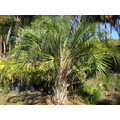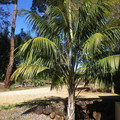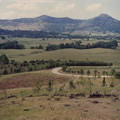Madagascar is a "garden of Eden" for bio-diversity. It is home to 10,000 plant species, 90% are found nowhere else in the world. It is the 4th largest island in the world, situated off the east coast of Africa slightly below the equator. In Australia the same latitude is from just above Brisbane to Cape York .It is 1580 km's long and 570 km's wide and has 6 different microclimates. The highest mountain is 2876 metres and a steep mountain range parallels the entire east coast.
Madagascar broke off from Gondwana 160 million years ago and then broke away from India 80 million years ago. It has an eastern and south-central rainforest area, a western dry forests area and a southern desert area.
- The climate is tropical and the rainy season is from Dec-April and the dry season is from May- Nov. The average rainfall is from 30 to 355 cm's annually and the average midday temperature in the dry season is 25 to 30 degrees c.
- Madagascar is home to 50 species of Lemur and with its rainforest they form an important part of the tourist economy.
- There are 170 known palm species, including around 90 species of Dypsis and 20 species of Ravenea. Some commonly known palms that come from Madagascar are the Golden Cane, Triangle, Majestic, Travellers palm, Bismark and the Baronii. The Golden Cane, Majestic, Baronii and most of the other palms come from the eastern and south-central rainforest area. The Bismark comes from the western dry grasslands.
- Every expedition into the interior of Madagascar's rainforests, valleys and mountains leads to the discovery of new species. A recently found new palm species named Tahina spectabilis has been found in a remote area in the NE of the island. This new species may even be a new genus; its closest relative is in Asia. Scientist's think that the new palm may have been isolated when Madagascar broke away from India and evolution has done the rest.
- This palm (Tahina spectabilis) grows to about 20 metres and after 50 or 100 years (depending on which website you read) the palm produces a massive seed head attracting large amounts of birds and insects etc. The palm then dies from exhaustion from the whole exercise.
The Palm Tree Family
The Arecaceae or Palmae commonly called the Pal Tree Family are an ancient monophyletic family (common ancestor). The Palm family has a genus of 202 with around 2500 species. They are in the group of Flowering Plants, which are either monocots or dicots with some exceptions. Palms are monocots. Monocots have one cotyledon (seed-leaf) and dicots have two cotyledons. Other major monocots are orchids and grasses and all their flowers are trimerous which means the flower parts are in multiples of 3, like 3, 6 or 9 petals.
Palms have evolved and now in their natural environment two- thirds grow in tropical climates though there are some notable exceptions.
The average life span of a palm is 150 to 200 years and new species are still being discovered. They grow either with a solitary trunk or in a cluster and their leaves are either feather or fan shaped. Australia is home to about 50 species with a couple being very important to the World.
When purchasing a palm it is important to choose a variety that suits the conditions of your local area. Consider temperature, rainfall, soil and also the space available for growth.
There are so many varying types of palms, recommend for your home environment. Check out what looks good and grows well in your area. Then it is sure to grow well for you. Go on line and cross-reference sites.
Although purchasing a smaller palm will be less expensive, it will take longer for it to grow to its potential and won't have that "instant gratification" of a large beautiful plant.
It would be better to purchase a medium to large sized plant. As younger palms are more vulnerable to the cold, a thicker and taller palm would have a better chance of withstanding the colder weather. Acclimation is often easier for larger plants and the growing season is the best time for planting.
Take notice of the sheltered conditions of where it was acquired and if it is sun hardened. If your type of palm flourishes in areas with high amounts of sunlight, but it was kept in a shaded area at your local nursery, it will take a couple months or more for the palm to be acclimatized to avoid such issues as sunburned leaves.
<< Previous Low Maintenance Palms | Back to Mullumbimby Palm Blog | Next >> Palm Delicacies - What Palm Fruits are Good to Eat



